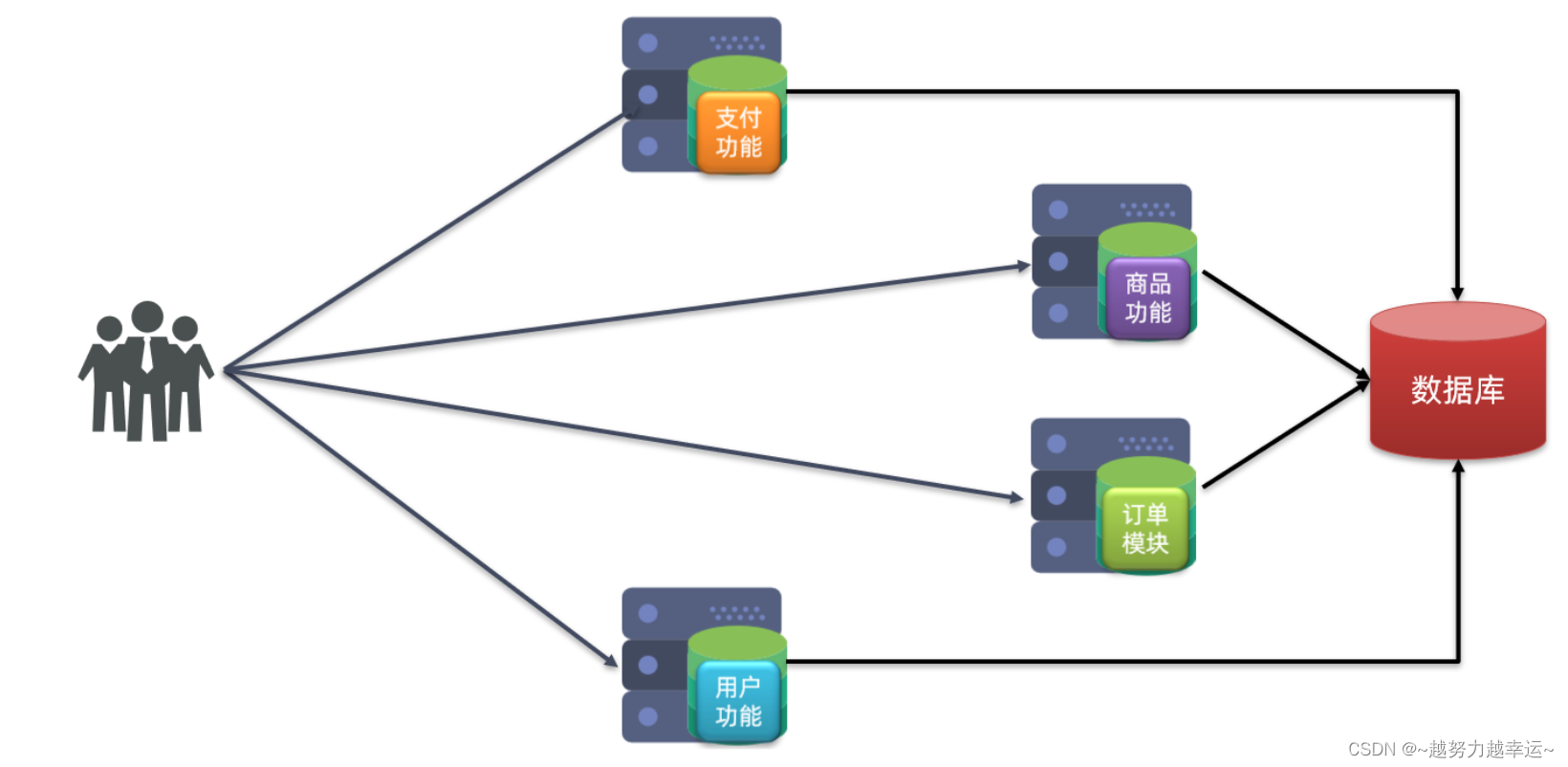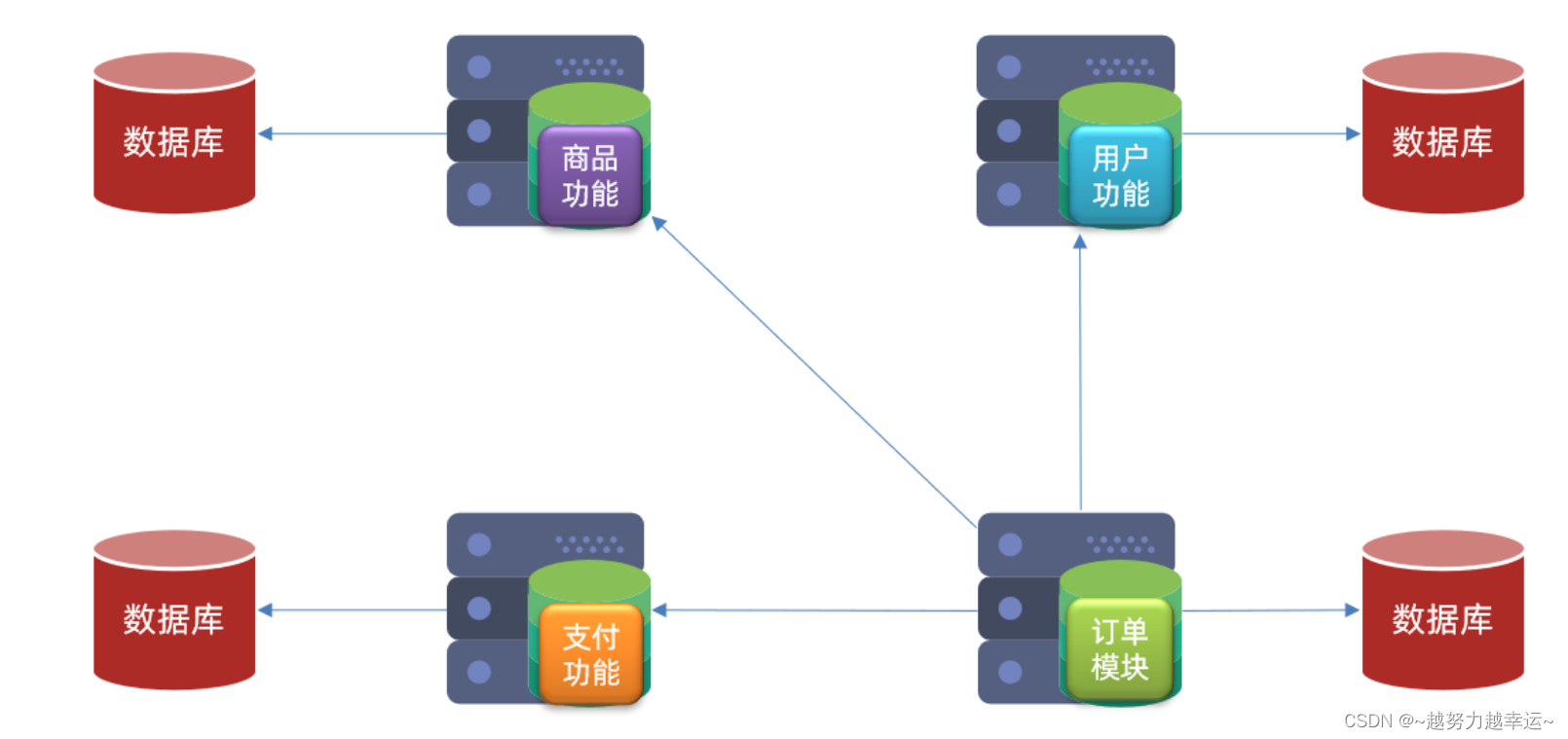SpringCloud
1.认识微服务
1.1单体架构
单体架构:将业务的所有功能集中在一个项目中开发,打成一个包部署

单体架构的优缺点:
**优点:**架构简单,部署成本低
**缺点:**耦合度高(维护困难,升级困难)
1.2分布式架构
分布式架构:根据业务功能对系统做拆分,每个业务功能模块作为独立项目开发,称为一个服务

**优点:**降低服务耦合,有利于服务升级和拓展
**缺点:**服务调用关系错综复杂
分布式架构虽然降低了服务耦合,但是服务拆分时也有很多问题需要思考:服务拆分的粒度、服务之间调用、服务之间调用关系的管理,需要制定一套行之有效的标准来约束分布式架构。
1.3微服务架构
微服务的架构特征:
- 单一职责:微服务拆分粒度小,每一个服务都对应唯一的业务能力,做到单一职责
- 自治:团队独立,技术独立,独立部署和交付
- 面向服务:服务提供统一标准的接口,与语言和技术无关
- 隔离性强:服务调用做好隔离、容错、降级、避免出现级联问题
微服务是一种经过良好架构设计的分布式架构方案
SpringCloud是目前国内使用最广泛的微服务框架。官网地址:https://spring.io/projects/spring-cloud
SpringCloud集成了各种微服务功能组件,并基于SpringBoot实现了这些组件的自动装配
其中常见的组件包括:
- 服务注册发现:Eureka、Nacos、Consul
- 服务远程调用:OpenFeign、Dubbo
- 服务链路监控:Zipkin、Sleuth
- 统一配置管理:SpringCloudConfig、Nacos
- 统一网关路由:SpringCloudGateway、Zuul
- 流控、降级、保护:Hystix、Sentinel
SpringCloud是微服务交媾的一站式解决方案,继承了各种优秀微服务功能组件
2.服务拆分
任何分布式架构都离不开服务的拆分,微服务也一样
微服务的拆分原则:
- 不同微服务,不要重复开发相同的业务
- 微服务数据独立,不要访问其他微服务的数据库
- 微服务可以将自己的业务暴露为接口,供其他微服务调用

3.远程调用
项目结构:

在order-service服务中,有一个根据id查询订单的接口:
package cn.itcast.order.web;import cn.itcast.order.pojo.Order;
import cn.itcast.order.service.OrderService;
import org.springframework.beans.factory.annotation.Autowired;
import org.springframework.beans.factory.annotation.Value;
import org.springframework.web.bind.annotation.GetMapping;
import org.springframework.web.bind.annotation.PathVariable;
import org.springframework.web.bind.annotation.RequestMapping;
import org.springframework.web.bind.annotation.RestController;@RestController
@RequestMapping("/order")
public class OrderController {@Autowiredprivate OrderService orderService;@GetMapping("/{orderId}")public Order queryOrderByUserId(@PathVariable("orderId") Long orderId) {// 根据id查询订单并返回return orderService.queryOrderById(orderId);}
}根据id查询订单,返回值是Order对象,如图
在user-service中有一个根据id查询用户的接口:
package cn.itcast.user.web;
import cn.itcast.user.pojo.User;
import cn.itcast.user.service.UserService;
import lombok.extern.slf4j.Slf4j;
import org.springframework.beans.factory.annotation.Autowired;
import org.springframework.beans.factory.annotation.Value;
import org.springframework.cloud.context.config.annotation.RefreshScope;
import org.springframework.format.annotation.DateTimeFormat;
import org.springframework.web.bind.annotation.*;
import java.time.LocalDateTime;
import java.time.format.DateTimeFormatter;@Slf4j
@RestController
@RequestMapping("/user")
public class UserController {@Autowiredprivate UserService userService;/*** 路径: /user/110** @param id 用户id* @return 用户*/@GetMapping("/{id}")public User queryById(@PathVariable("id") Long id) {return userService.queryById(id);}
}
查询的结果如图:
**案例需求:**修改order-service中的根据id查询订单业务,要求在查询订单的同时,根据订单中包含的userId查询出用户信息,一起返回
分析:需要在order-service中向user-service发起一个http请求,调用http://localhost:8081/user/{userId}接口
步骤:
- 注册一个RestTemplate的实例到Spring容器
- 修改order-service服务中的OrderService类中的queryOrderById方法,根据Order对象中的userId查询User
- 将查询的User填充到Order对象中返回
package cn.itcast.order.pojo;
import cn.itcast.pojo.User;
import lombok.Data;
//Order实体类
@Data
public class Order {private Long id;private Long price;private String name;private Integer num;private Long userId;private User user;
}
package cn.itcast.order;import org.mybatis.spring.annotation.MapperScan;
import org.springframework.boot.SpringApplication;
import org.springframework.boot.autoconfigure.SpringBootApplication;
import org.springframework.context.annotation.Bean;
import org.springframework.web.client.RestTemplate;@MapperScan("cn.itcast.order.mapper")
@SpringBootApplication
public class OrderApplication {public static void main(String[] args) {SpringApplication.run(OrderApplication.class, args);}@Beanpublic RestTemplate restTemplate() {return new RestTemplate();}
}
实现远程调用:
package cn.itcast.order.service;import cn.itcast.feign.UserClient;
import cn.itcast.pojo.User;
import cn.itcast.order.mapper.OrderMapper;
import cn.itcast.order.pojo.Order;
import org.springframework.beans.factory.annotation.Autowired;
import org.springframework.stereotype.Service;@Service
public class OrderService {@Autowiredprivate OrderMapper orderMapper;@Autowiredprivate RestTemplate restTemplate;public Order queryOrderById(Long orderId) {// 1.查询订单Order order = orderMapper.findById(orderId);//2.调用user微服务接口,根据userId得到用户信息String url = "http://userservice/user/" + order.getUserId();User user = restTemplate.getForObject(url, User.class);//3.封装user数据到orderorder.setUser(user);// 4.返回return order;}
}










![[点云分割] 条件欧氏聚类分割](http://pic.xiahunao.cn/[点云分割] 条件欧氏聚类分割)



:品牌管理页面的增删改查)




